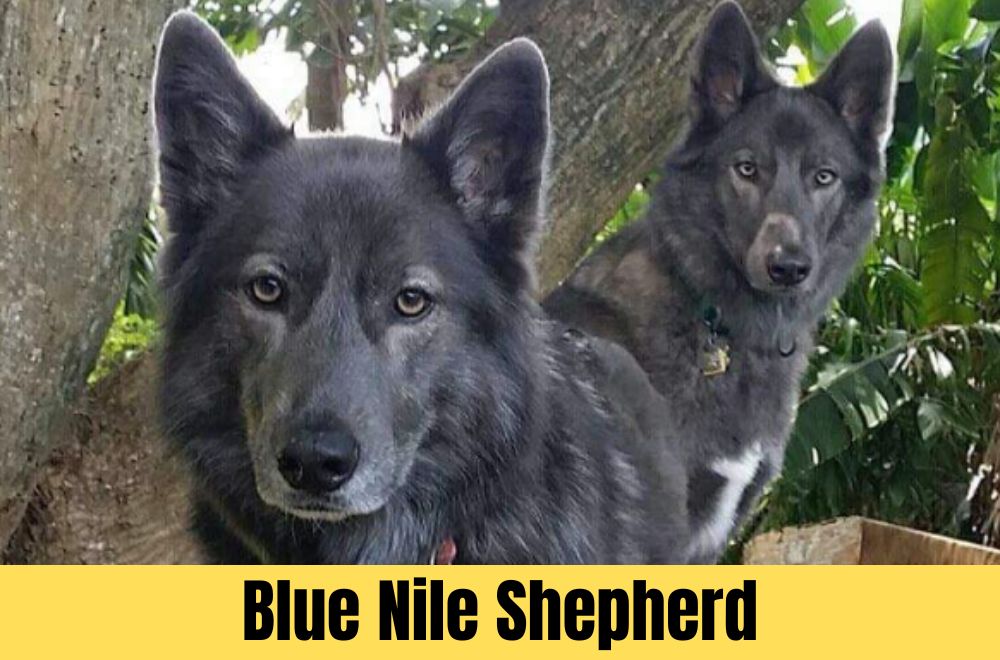The Blue Nile Shepherd, an intriguing and distinctive dog breed, has been making waves in the canine world with its unique qualities and striking appearance.
In this comprehensive guide, we will explore the key features, history, and temperament of the Blue Nile Shepherd, shedding light on what makes this breed stand out.
The Blue Nile Shepherd: A Unique Canine Companion

Source: Pinterest.com
The Blue Nile Shepherd, sometimes known as the Blue Nile, is a very uncommon breed of dog that originated in the lush areas around the Blue Nile River in East Africa. This breed has been meticulously developed for its versatility, excelling in roles such as herding livestock and guarding homesteads.
Appearance
One of the most distinctive characteristics of the Blue Nile Shepherd is its majestic appearance. These dogs are medium to large, displaying a strong and muscular build that reflects their heritage as working dogs.
The coat of a Blue Nile Shepherd is typically dense and can come in a variety of colors, including shades of blue, grey, and black. Because it is sleek and short, not much maintenance is needed.
The large head of the dog features a snout, unlike the other dogs. Their sharp ears are the reason behind their outstanding listening ability and attitude of alertness and attentiveness.
Their widely apart eyes convey confidence and intelligence. The magnificent beauty of the Blue Nile Shepherd is enhanced by its curled tail.
History and Origin

Source: Pinterest.com
The Blue Nile Shepherd’s history is deeply intertwined with the agricultural landscapes of East Africa. Local farmers and herders selectively bred these dogs to assist in managing livestock and protecting homes from potential threats.
Their strong work ethic, intelligence, and loyalty quickly garnered attention beyond their place of origin, leading to a growing appreciation for this exceptional working companion.
Despite the Blue Nile Shepherd breed’s relative rarity worldwide, efforts are being made to protect and develop it so that future generations can continue to benefit from its legacy.
Temperament
Blue Nile Shepherds are known for their strong and protective instincts, making them excellent guardians for both livestock and families.
Despite their intimidating exterior, these canines are typically kind and kind toward their human friends. Early socialization is crucial to ensure they grow up to be well-rounded and adaptable.
Their intelligence and quick learning make Blue Nile Shepherds versatile, excelling in various roles such as herding, guarding, and participating in dog sports. To keep their bodies and brains active, they must regularly participate in mental stimulation and physical exercise.
While the Blue Nile Shepherd dog boasts a unique heritage as a versatile working companion, the regal presence of a Rottweiler dog in a family setting adds another layer of loyalty and protection.
Training and Socialization

Source: Pinterest.com
Training a Blue Nile Shepherd requires a consistent and firm approach. Their intelligence allows them to quickly grasp commands, but their strong independent streak necessitates patient and consistent training methods. Positive reinforcement proves to be highly effective in shaping a well-behaved Blue Nile Shepherd.
Socialization is equally important, given their protective instincts. Early exposure to different people, environments, and situations ensures Blue Nile Shepherds develop into well-mannered and confident adults, particularly when integrated into a family setting.
Health Considerations

Source: Pinterest.com
Ensuring the well-being of Blue Nile Shepherds involves a holistic approach that encompasses nutrition, exercise, and vigilant veterinary care. Like any breed, Blue Nile Shepherds may be susceptible to specific health issues, underscoring the importance of proactive measures to maintain their overall health.
Diet and Nutrition
A balanced and nutritious diet is fundamental to the health of Blue Nile Shepherds. These dogs benefit from a diet rich in high-quality proteins, essential fats, and appropriate carbohydrates.
Consultation with a veterinarian can help tailor a diet to meet the specific needs of this breed, taking into account factors such as age, size, and activity level.
Exercise Requirements
Blue Nile Shepherds are known for their agility and strength, and regular exercise is crucial to keep them physically and mentally stimulated. Engaging in activities like daily walks, play sessions, and, if possible, herding exercises can contribute to their overall well-being.
Regular exercise not only helps maintain a healthy weight but also supports their mental health by preventing boredom-related behaviors.
Routine Veterinary Exams
Regular veterinary check-ups are essential for Blue Nile Shepherds to detect and address potential health issues early on. These exams should include a thorough assessment of their physical condition, dental health, and vaccinations.
Preventive care, such as parasite control and dental cleanings, plays a vital role in ensuring their long-term health and well-being.
Genetic Considerations
Conscientious breeding practices are paramount in minimizing genetic issues within the Blue Nile Shepherd breed. Responsible breeders prioritize the health and genetic diversity of their breeding lines, reducing the likelihood of hereditary conditions.
Prospective owners should seek reputable breeders who adhere to ethical breeding standards and prioritize the health and temperament of the dogs they produce.
FAQs Related to Blue Nile Shepherd Dog
Question #1: What makes the Blue Nile Shepherd unique?
The Blue Nile Shepherd is unique in its appearance, with a strong and muscular build, dense coat in various colors, and a regal posture. Their history as working dogs, developed by local farmers and herders, adds to their uniqueness.
Question #2: What is the history of the Blue Nile Shepherd?
The breed’s origins are deeply ingrained in East Africa, where its guarding and herding prowess led to selective breeding. The Blue Nile Shepherd was created to help with livestock management, but its loyalty and intelligence soon spread beyond its native region.
Question #3: How do Blue Nile Shepherds behave as family pets?
Despite their imposing appearance, Blue Nile Shepherds are known for their gentle and affectionate nature with their human companions. Proper socialization from an early age ensures they become adaptable and well-mannered family members.
Question #4: What is the training process for Blue Nile Shepherds?
Training a Blue Nile Shepherd dog requires a consistent and firm approach. Their intelligence allows for quick learning, but a strong independent streak necessitates patient and consistent methods. Positive reinforcement is highly effective in shaping a well-behaved Blue Nile Shepherd.
Question #5: Are Blue Nile Shepherds good with children and other pets?
Yes, with proper socialization, Blue Nile Shepherds can be excellent companions for children and other pets. Their protective instincts make them reliable guardians, and their gentle nature ensures compatibility in family settings.
Question #6: What health considerations should be kept in mind for Blue Nile Shepherds?
Blue Nile Shepherds are prone to specific health problems, just like any other breed. Their general health depends on regular exercise, a balanced diet, and veterinarian examinations regularly. Maintaining their health also heavily depends on responsible breeding methods.
Conclusion
In conclusion, the Blue Nile Shepherd stands as a captivating and versatile breed with a rich history and a unique set of qualities. Whether serving as a dependable working companion in the fields of East Africa or as a loyal and loving family pet elsewhere, the Blue Nile Shepherd has proven itself to be a remarkable breed.
As efforts continue to raise awareness and preserve its heritage, the future looks bright for this majestic and noble dog.


